-

人教版高中地理必修2城市内部空间结构精品教案
过渡:在实际生活中,城市内部空间结构并非完全按照这一经济规律呈现,而是更具复杂性。这说明除了经济因素外,还有很多其他因素在起作用,请大家结合你的认识、图2.9和案例1:纽约市的少数民族区谈谈你的看法。(2)其他因素I.收入 —— 形成不同级别住宅区的常见原因。有能力支付昂贵租金和选择最佳居住环境的人,其居住地往往形成高级住宅区。II.知名度 ——城市内某些地区在历史、文化或经济方面具有很高的声誉,这往往会吸引更多新的住宅或商场建在该处,以提高其知名度。III.种族聚居区的形成 ——在有些城市的某一区域内,如果某个种族或宗教团体占优势,就可能形成种族聚居区。如纽约市的唐人街、哈林区、小意大利区等。IV历史因素——城市的建筑物和街道设计可以维持久远,早期的土地利用方式对日后的功能分区有着深远的影响。3、城市内部空间结构的形成和变化

人教版高中地理必修2不同等级城市的服务功能教案
1、 前提条件:①环境几乎一样的平原地区,人口分布均匀2、 ②区域的运输条件一致,影响运输的惟一因素是距离。城市六边形服务范围形成过程。(理解)a.当某一货物的供应点只有少数几个时,为了避免竞争、获取最大利润,供应点的距离不会太近,它们的服务范围都是圆形的。 b.在利润的吸引下,不断有新的供应点出现,原有的服务范围会因此而缩小。这时,该货物的供应处于饱和。每个供应点的服务范围仍是圆形的,并彼此相切c.如果每个供应点的服务范围都是圆形相切却不重叠的话,圆与圆之间就会存在空白区。这里的消费者如果都选择最近的供应点来寻求服务的话,空白区又可以分割咸三部分,分别属于三个离其最近的供应点。[思考]①图2.15中城市有几个等级?②找出表示每一等级六边形服务范围的线条颜色?③叙述不同等级城市之间服务范围及其相互关系?3、理论基础:德国南部城市4、意义:运用这种理论来指导区域规划、城市建设和商业网点的布局。1、 应用——“荷兰圩田居民点的设置”。
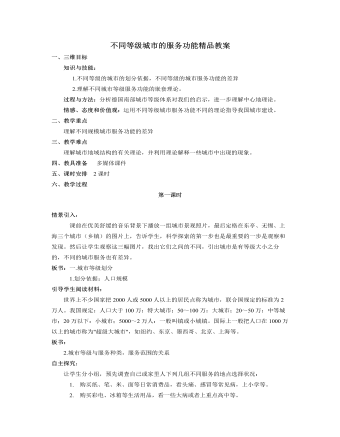
人教版高中地理必修2不同等级城市的服务功能精品教案
学生探究案例:找出不同等级城市的数目与城镇级别的关系、城镇的分布与城镇级别的关系并试着解释原因。在此基础上,指导学生一步步阅读书上的阅读材料,首先说明这是德国著名的经济地理学家克里斯泰勒对德国南部城市等级体系研究得出的中心地理论,他是在假设土壤肥力相等、资源分布均匀、没有边界的平原上,交通条件一致、消费者收入及需求一致、人们就近购买货物和服务的情况下得出的理想模式。然后指导学生阅读图2.14下文字说明,理解城市六边形服务范围形成过程。指导学生读图2.15,找出图中城市的等级、每一等级六边形服务范围并叙述不同等级城市之间服务范围及其相互关系,从而得出不同等级城市的空间分布规律,六边形服务范围,层层嵌套的理论模式。给出荷兰圩田空白图,让学生应用上面的理论规划设计居民点并说出理由,再和教材上的规划进行对照。然后给出长三角地区城市分布图和各城市人口数,让学生对这些城市进行分级,概括每一级城市的服务功能、统计每一等级城市的数目以及彼此间的平均距离,总结城市等级与服务范围、空间分布的关系?
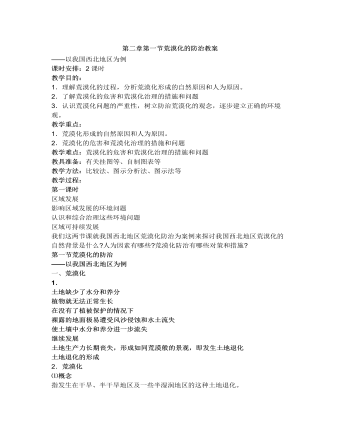
人教版高中地理必修3第二章第一节荒漠化的防治教案
1.根据下面的图文资料,说明前苏联垦荒区土壤风蚀的潜在自然背景。并说明人们的生产活动怎样加剧了这个过程。点拨:对图2.16的分析,要知道”垦荒地区”处于亚欧大 陆的中部偏北的地方,虽处于西风带但远离水汽来源,故降水稀少。从其周边的内陆湖“里海”、“咸海”的分布特点,可以推断,这是一个半荒漠向干草原的过渡地带,是一个生态环境比较脆弱的地区,其自然地理状况必定是寒冷、干旱、大风。2.20世纪60年代中期以来,前苏联在总结大规模垦荒经验教训的基础上,采取了一系列综合防护措施。仔细分析这些措施,你认为该地区防治荒漠化(土壤风蚀)的主要方向是什么?点拨:要善于将所列四项保护措施逐条进行分析,而后进行归纳,不难找出它们之间的共同的东西,那就是“抗旱、防风、保水、保土、保肥”。3.根据所学知识,你认为前苏联垦荒区防治荒漠化的对策与措施可以被我国的哪些地区所借鉴。

人教版高中地理必修3第四章第二节区域工业化与城市化教案
从右图“进出口贸易占全国的比重”可看出,珠三角地区的外向型经济特征很明显,但正在缓慢的发生转变;而长三角地区的外贸依存度在10年内迅速增长。由此可见,珠三角地区城市化过程,是伴随着该地特殊的经济发展相对自发地快速推进,缺乏宏观而理性的规划。阅读通过此阅读材料,使学生大致了解以下内容深圳作为珠江三角洲地区迅速城市化的一个典型代表,到目前为止,对其未来发展道路的构想,主要集中在:如何联合和依托临近区域、联合优势资源,扩大发展空间;如何明确功能,重新定位,合理分工,突出特色。活动长江三角洲地区城市的协调发展1.读图4.28,如果按人口规模>500万人、100万~500万人、50万~100万人、20万~50万人和<20万人将城市分为五级的话,分析长江三角洲地区城市的等级规模结构是否合理,这对其城市的协调发展有何影响?
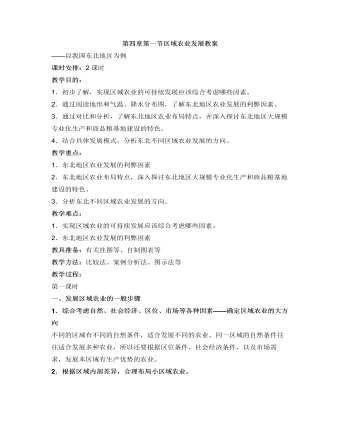
人教版高中地理必修3第四章第一节区域农业发展教案
1.根据下面的材料,归纳珠江三角洲发展基塘生产有利的地理条件。珠江三角洲地势低平,河网密布,降水充沛。北回归线从珠江三角洲的北部穿过。桑树和甘蔗主要分布于热带和亚热带。广州是古代海上丝绸之路的起始地之一。水产品在广东人的食物结构中占有较大的比重。点拨珠江三角洲地区发展基塘农业生产有利条件可以结合材料,归纳为三个方面:地形、气候、市场(当地和海外)具体分析略。2.图4.16所示的基塘生产将哪些产业联系起来?哪些副产品(或废弃物)被充分利用起来?这种联系对农村经济发展有什么作用?点拨基塘生产环节将种植业(桑、蔗等)、养殖业(养蚕、养鱼)、工业(丝厂、糖厂)等几种产业紧密的联系在一起。在此环节中,塘泥、蚕沙(蚕屎)、蚕蛹、缫丝、滤泥、蔗叶等副产品被充分的回收利用。养蚕业、蔗糖加工业同塘鱼养殖业紧密结合,作为一种综合的经营,几者之间相互依存、相互促进、扬长补短,有机地循环联系起来。
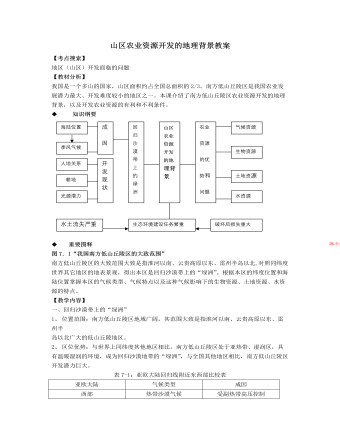
人教版高中地理选修2山区农业资源开发的地理背景教案
图7.1“我国南方低山丘陵区的大致范围”南方低山丘陵区的大致范围大致是指淮河以南、云贵高原以东、雷州半岛以北,对照同纬度世界其它地区的地表景观,得出本区是回归沙漠带上的“绿洲”。根据本区的纬度位置和海陆位置掌握本区的气候类型、气候特点以及这种气候影响下的生物资源、土地资源、水资源的特点。【教学内容】一、回归沙漠带上的“绿洲”1、 位置范围:南方低山丘陵区地域广阔,其范围大致是指淮河以南、云贵高原以东、雷州半岛以北广大的低山丘陵地区。2、 区位优势:与世界上同纬度其他地区相比,南方低山丘陵区处于亚热带、湿润区,具有温暖湿润的环境,成为回归沙漠地带的“绿洲”,与全国其他地区相比,南方低山丘陵区开发潜力巨大。
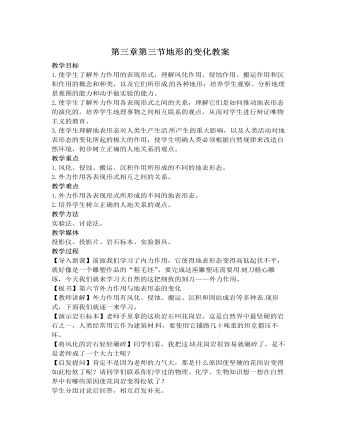
人教版高中地理选修1第三章第三节地形的变化教案
在自然界也是如此,可以看到砾石、沙、粉砂、粘土等颗粒大小不同的沉积物。【出示投影片提问】(河流下游三角洲示意图)这是一幅河流下游三角洲的示意图,你能用沉积作用的原理来解释它的形成过程吗?学生讨论、回答。【教师小结】河流携带着大量的泥沙,到达下游时由于流速降低,泥沙大量沉积,常常会形成宽广平坦的三角洲和冲积平原。在那里土壤肥沃,灌溉便利,通常是良好的农业区。【转折过渡】流水的沉积作用给人类带来了肥沃的冲积平原,风力的沉积作用给人类又带来了什么呢?【分析讲解】在沙漠中有大量的沙丘,这些沙丘在风力作用下会成为流动沙丘,掩没农田和村庄,甚至是整个城市。人类正在探索控制沙漠扩展的方法。【转折过渡】沉积物经过物理的、化学的以及生物化学的变化和改造,又会重新变成坚硬的岩石,这种作用叫做团结成岩作用。

人教版高中地理选修2国土整治与区域开发教案
【考点搜索】理解中国国土整治的必要性、主要内容及其与区域可持续发展的关系。【教材分析】本课是我国国土整治与区域发展的一个开篇,目的是让学生了解国土整治的概念、意义、我国进行国土整治的必要性和迫切性、我国国土整治的重点工程、国土整治与区域发展的关系。使学生了解我国实施国土整治与区域发展的一些基本理论和原则,为以后各单元讨论典型地区的国土整治与区域发展奠定理论基础。◆重要图释1、图2.2“中国防护林体系规划示意图”防护林体系工程是中国生态工程建设的基本框架,覆盖了我国主要水土流失区、风沙危害区、盐碱区和台风区。图中深绿色区域为“三北”防护林体系建设规划区、浅绿色区域为长江中上游防护林体系建设规划区、紫色区域为沿海防护林体系建设规划区。其中“三北”防护林体系工程是世界最大的生态工程。

人教版高中地理选修2三个经济地带的特征、差异与发展教案
4、在西部大开发中,铁路等基础设施必须先行。这主要是因为铁路建设()A.投资规模巨大,建设周期长B.提供就业机会,提高人均收入C.加快商品流通,促进共同发展D.投资回报较高,实现持续发展5、根据我国三个经济地带的发展理论,西部经济地带将建成()A.水电基地B.商品粮基地C.有色金属等原材料基地D.石油和畜牧业基地6、对三个经济地带协调发展的理解,正确的是()A.地区间的协调发展,应逐渐缩小各地带的经济差距或使扩大的趋势有所缓解B.产业间的协调发展,形成合理的地区产业结构和产业特色C.优势互补,合理分工,平均发展D.把中西部的资源优势转化为经济优势,全部就地加工石油和天然气资源7、下列有关三个经济地带发展的叙述,正确的是()A.把部分劳动密集型加工企业逐步转移到中西部B.把农牧产品加工企业逐步转移到东部C.优先安排东部地区基础设施和资源开发项目D.充分发挥三个地带各自的优势,实现协调发展
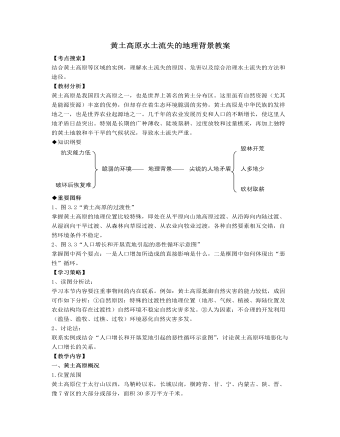
人教版高中地理选修2黄土高原水土流失的地理背景教案
(4)历史上有“黄河百害,唯富一套”之说。上游的宁夏、河套平原由于 形成了富庶的农业区;“害”主要发生在它的 河段,消除水害的主要措施是 和 。(5)沿河地区资源丰富,按注重发展优势产业和特色产业的构想,开发 资源,为兰州发展化学、冶金等多种工业提供了有利条件;利用 资源,在内蒙古、山西等省区发展高能耗工业。解析:本题立意在于考查学生掌握我国区域地理特征与比较分析地理现象解决地理问题的能力,具体考查学生有关黄河水系的知识与能力。本题以黄河水系为主线,将一系列的地理事物现象贯穿起来,同时又与西部大开发战略的相关知识相结合,立意比较新颖。紧密联系实际,高考导向作用明确,是一条比较优秀的高考题。答案:(1)雨水是主要补给季风(2)暴涨上游河套和下游河口(3)流量大;水利枢纽多,起调节作用人口少,工农业生产需水量较少(4)引黄灌溉下游中游水土保持,发挥水利枢纽的调节功能;下游加固大堤(5)水能煤炭
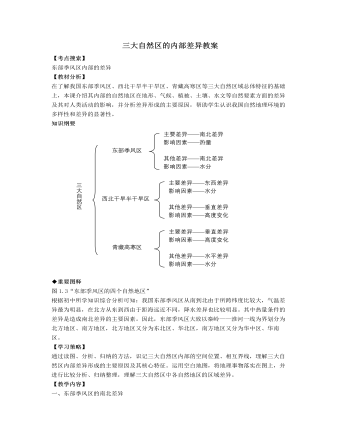
人教版高中地理选修2三大自然区的内部差异教案
【知能训练】一、选择题(第1-5题为单项选择题,第6-7题为双项选择题)东北温带湿润、半湿润地区内的三江平原有“北大荒”之称,如今“北大荒”已被人们称为“北大仓”。据此完成1-2题:1、下列关于三江平原的叙述,正确的是()A.地处中温带湿润地区B.因粮食单位面积产量高而成为全国性的商品粮基地之一C.土壤因富含矿物质而形成肥沃的黑土D.夏季高温且雨热同期,利于冬小麦、玉米种植2、目前,三江平原还有大片沼泽荒地,但2000年国务院下令停止围垦,其主要原因是()A.我国已加入WTO,可以从国际市场大量廉价进口粮食B.保护“湿地”有利于改善生态环境C.开展多种经营,发展菱藕等水生植物生产D.煤、石油等矿产资源丰富,今后转向矿产资源开发利用3、我国西部地区的地理差异有()A.甘新多沙漠戈壁,青藏多大河湖泊B.陕甘宁地势低平,云贵川地形崎岖
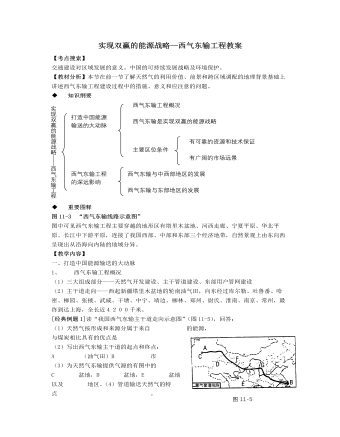
人教版高中地理选修2实现双赢的能源战略—西气东输工程教案
图11-3 “西气东输线路示意图”图中可见西气东输工程主要穿越的地形区有塔里木盆地、河西走廊、宁夏平原、华北平原、长江中下游平原,连接了我国西部、中部和东部三个经济地带,自然景观上由东向西呈现出从沿海向内陆的地域分异。【教学内容】一、 打造中国能源输送的大动脉1、 西气东输工程概况(1)三大组成部分——天然气开发建设、主干管道建设、东部用户管网建设(2)主干道走向——西起新疆塔里木盆地的轮南油气田,向东经过库尔勒、吐鲁番、哈密、柳园、张掖、武威、干塘、中宁、靖边、柳林、郑州、尉氏、淮南、南京、常州,最终到达上海,全长近4200千米。[经典例题1]读“我国西气东输主干道走向示意图”(图11-5),回答:(1)天然气按形成和来源分属于来自 的能源,与煤炭相比具有的优点是
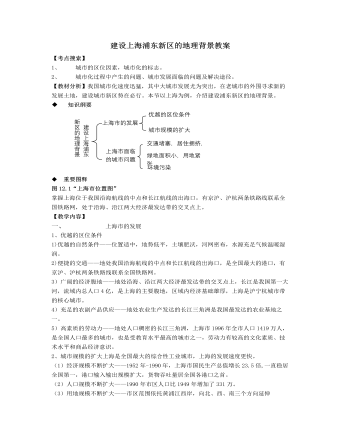
人教版高中地理选修2建设上海浦东新区的地理背景教案
2、上海是全国最大的商业中心,上海港是全国最大的港口。商业中心区位选择因素与港口的区位选择因素的共性条件是( )A、自然地理条件B、经济地理条件C、地理位置D、经济腹地3、中国政府宣布开发上海浦东的时间是( )A、1978年B、1985年C、1989年D、1990年4、有关上海优越区位条件的叙述,错误的是( )A、长江三角洲可提供充足的农副产品B、是全国最大的交通枢纽C、是我国最大城市带的核心城市D、是我国面积最大的直辖市5、目前上海市面临的最主要的人口问题是( )A、人口老龄化,青壮年赡养照顾众多老人负担过重B、卫星城镇人口比重大C、人口基数大,自然增长率高D、人口年龄构成轻,生育高峰压力大6、城市问题产生的主要原因是( )A、城市规模扩大B、城市基础设施相对滞后C、城市管理混乱D、城市人口规模和经济规模的迅速扩大7、下列可反映上海市的城市问题的是( )A、上海市区人均道路面积略高于北京市区B、上海市沙尘暴天气多发C、上海市许多家庭三代人同室居住D、上海市人均绿地面积稍高于重庆
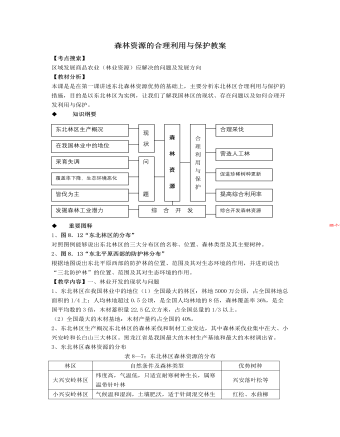
人教版高中地理选修2森林资源的合理利用与保护教案
1、图8.12“东北林区的分布”对照图例能够说出东北林区的三大分布区的名称、位置、森林类型及其主要树种。2、图8.13“东北平原西部的防护林分布”根据地图说出东北平原西部的防护林的位置、范围及其对生态环境的作用,并进而说出“三北防护林”的位置、范围及其对生态环境的作用。【教学内容】一、林业开发的现状与问题1、东北林区在我国林业中的地位(1)全国最大的林区:林地5000万公顷,占全国林地总面积的1/4上;人均林地超过0.5公顷,是全国人均林地的8倍,森林覆盖率36%,是全国平均数的3倍,木材蓄积量22.5亿立方米,占全国总量的1/3以上。(2)全国最大的木材基地:木材产量约占全国的40%。2、东北林区生产概况东北林区的森林采伐和制材工业发达,其中森林采伐业集中在大、小兴安岭和长白山三大林区。黑龙江省是我国最大的木材生产基地和最大的木材调出省。3、东北林区森林资源的分布
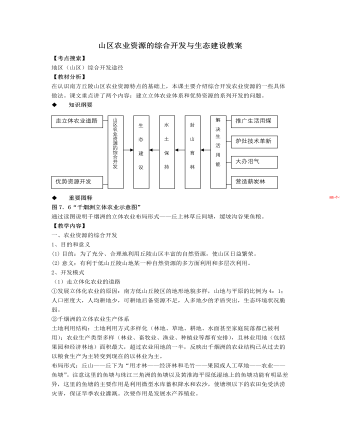
人教版高中地理选修2山区农业资源的综合开发与生态建设教案
【教学内容】一、农业资源的综合开发1、目的和意义(1) 目的:为了充分、合理地利用丘陵山区丰富的自然资源,使山区日益繁荣。(2) 意义:有利于低山丘陵山地某一种自然资源的多方面利用和多层次利用。2、开发模式(1)走立体化农业的道路①发展立体化农业的原因:南方低山丘陵区的地形地貌多样,山地与平原的比例为4:1;人口密度大,人均耕地少,可耕地后备资源不足,人多地少的矛盾突出,生态环境状况脆弱。②千烟洲的立体农业生产体系土地利用结构:土地利用方式多样化(林地、草地、耕地、水面甚至家庭院落都已被利用);农业生产类型多样(林业、畜牧业、渔业、种植业等都有安排),且林业用地(包括果园和经济林地)面积最大,超过农业用地的一半,反映出千烟洲的农业结构已从过去的以粮食生产为主转变到现在的以林业为主。布局形式:丘山——丘下为“用才林——经济林和毛竹——果园或人工草地——农业——鱼塘”。
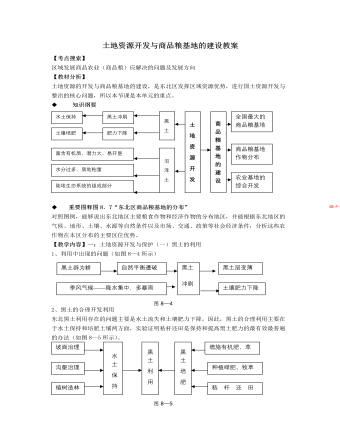
人教版高中地理选修2土地资源开发与商品粮基地的建设教案
3、东北区商品粮基地的建设松嫩平原和三江平原是我国最重要的商品粮基地,三江平原所能够提供的商品粮比重在全国最大,而且开发历史短、地广人稀、土地资源丰富、具有较大的开发潜力。4、东北区商品粮基地的综合开发东北区农业基地的综合开发,就是要在不断提高种植业本身生产潜力的基础上,大力发展养殖业和农产品加工业,使农产品多层次大幅度升值。总结:搞好商品粮基地和林业基地建设,必须从改善农业生态环境出发,坚持开发和利用、治理和保护相结合,坚持经济效益、生态效益相统一。这就要求不能通过大幅度开垦荒地、增加耕地面积来发展粮食生产,发挥现有耕地的生产潜力,提高单产是今后实现粮食增产的根本途径。【知能训练】一、选择题(第1-4题为单项选择题,第5-6题为双项选择题)1、保护和提高黑土肥力最有效的办法是 ( )A、秸秆还田B、增施化肥C、植树造林D、焚烧秸秆

人教版高中地理选修2西南区交通运输建设与区域经济发展教案
1、图9.6“南昆铁路示意图”掌握南昆铁路起止点、支线、途经地区、铁路线附近的矿产资源(云南的磷矿、贵州的煤矿、广西的铝矿等);南昆铁路使西南区南连北海、防城港、湛江、钦州等港,成为西南区通往沿海地区最便捷的出海通道,使西南地区物资出海路程缩短了600千米,对西南区的发展具有十分重要的经济、政治、战略意义。2、图9.10“西南三省一市和广西主要铁路分布图”本图展现了西南三省一市和广西的主要铁路分布,要求重点掌握本区内的环状铁路——成渝-川黔-贵昆-成昆线,新建的南昆线、内昆线,以及宝成线(联系西北区),襄渝线、湘黔线和湘桂-黔桂线(联系中南区),枝柳线(联系中南区和华北区)等区际铁路,昆河线等国际铁路及重要铁路枢纽。3、图9.11“西藏自治区交通图”西藏自治区是我国目前唯一没有正式通铁路的省级行政区,读图后要能掌握联系拉萨的四大入藏(川藏、青藏、新藏、滇藏)公路及正在建设的青藏铁路。

人教版高中地理选修2我国的三个经济地带教案
1、 下列四组地形中,全部属于西部大开发区域的是()A.江南丘陵——阿尔泰山——云贵高原——祁连山B.柴达木盆地——天山——江南丘陵——云贵高原C.准噶尔盆地——云贵高原——青藏高原——横断山D.塔里木盆地——云贵高原——黄土高原——太行山2、“西气东输”工程起始于()A.哈密盆地B.塔里木盆地C.柴达木盆地D.吐鲁番盆地3、 西部地区正在大力发展水电事业,其中已经建成并在最近开始向上海输送电能的水电站是()A.二滩水电站B.丹江口水电站C.龙羊峡水电站D.新安江水电站4、目前进入西藏地区主要依靠公路。下列四条进藏公路中,海拔最高的是()A.青藏公路B.川藏公路C.滇藏公路D.新藏公路5、青藏铁路将经过三江源(长江、黄河、澜沧江之源)地区。下列关于该地区地理环境特点的叙述,正确的是()A.山高坡陡,地势起伏大B.太阳辐射强,日照时间长,热量充足C.气温低,牧草矮,生态环境脆弱D.积雪冰川多,水资源和水能资源丰富
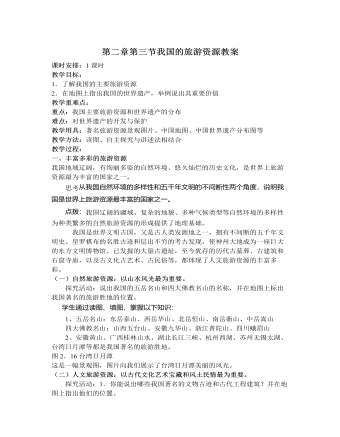
人教版高中地理选修3第二章第三节我国的旅游资源教案
2.对世界遗产的开发与保护原则——保护第一我国的世界文化遗产、世界文化与自然双遗产具有时代性、不可再生性和不可替代性,我国的世界自然遗产都代表着某一类地质地貌中最重要的历史演化过程,展示了我国独特的地质地貌和生物资源。世界遗产的开发与保护之间存在一定的矛盾。我们必须坚持保护第一的原则。旅游开发只是世界遗产的功用之一,必须十分慎重,做到保护与开发协调统一,不能造成对世界遗产的任何破坏。案例②我国第一个世界文化与自然双遗产——泰山通过学习案例②,了解到:①泰山不仅具有科学价值较高的地质构造,还具有多样的地貌景观,罕见的天象景观,丰富的生物资源。泰山自古以来即被誉为名山,受到皇家和百姓的顶礼膜拜,各朝各代几乎都进行过封禅行为,从而留下了深厚的历史文化遗存,这一点跟其他名山相比是独一无二的。

